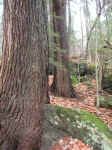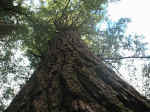I was in Connecticut earlier this week and got the chance to
visit
Catlin's Woods near Litchfield and the Great Mountain Forest
near
Norfolk.
Catlin's Woods is preserved as part of the White Memorial
Foundation
Conservation Center. A north-south trail bisects the big trees,
which
are primarily hemlock across the southern half of the stand and
white
pine across the northern half. I estimated the taller hemlock to
be in
the 85 to 105 foot range and the tallest white pine around 120
feet. I
measured a fallen white pine at 109 feet. The greatest girth for
a
hemlock was 37.9 inches dbh. For white pine the two thickest
were 40.8
inches and 39.1 inches dbh. Other species found here include
black and
yellow birch, beech and white oak. The topography is fairly flat
and not
rocky, unlike most of the old growth stands in the far NW part
of the
state.
 |
The biggest hemlock in Catlin's Woods, about 9.9 feet in
circumference. |
 |
Fallen white pine log, measured to 109 feet. |
 |
One of the bigger white pines, about 10.3 feet in circumference.
Note the burl on the left side of the trunk. |
 |
The biggest white pine, about 10.7 feet in circumference and about
120 feet tall. |
Thanks to Eleanor Tillinghast, I was able to reach Starling
Childs of
the Great Mountain Forest at Norfolk, CT and get directions to
two small
stands of old hemlocks there:
The Bigelow Pond site contains about a 5-10 acre, east-west
oriented
stand of old growth hemlocks. An article published in Bulletin
No. 9 of
the Connecticut Arboretum (1956) by H.I. Winer and E.C. Childs
describes
the site as being part of the original forest. Coring data
suggests only
minor disturbance and places the older hemlocks at 350-400 years
old.
The trees extend from the western edge of Bigelow Pond (which
was formed
by the damming of a small stream back in the colonial era) up a
gentle,
but rocky slope. According to the reference cited above
"the depth from
litter to bed rock seldom exceeds 12 inches, and over much of
the area
hemlock as established itself directly on rocks covered by only
a thin
layer of litter or moss." The ice sheet left impressive
boulders strewn
all about the forest here. I estimated the tallest hemlocks at
about 85
to 105 feet (the reference gives a max height for hemlock of 110
feet).
Other species include beech, birch (black, yellow and paper),
sugar
maple and white ash. I measured the girth of several hemlocks
and the
biggest was 39.5 inches. The median of the half dozen bigger
hemlocks I
measured was about 32 inches.
 |
The Bigelow Pond hemlocks seen from a distance. The old trees
cover the slope up to the horizon in the middle of the photo. |
 |
he old hemlocks are growing among a field of boulders arranged
by the ice sheet. |
 |
Some hemlocks are actually growing around the boulders. |
 |
An old beech tree near the pond and at the southern edge of the
old hemlocks. |
 |
Paper, yellow and black birch, from left to right with a small
beech in the foreground and hemlocks in the background. |
 |
The distinctive branch structure of an old hemlock. |
 |
The flared bases and limbless trunks of two grand silent
sentinels of the forest...veterans of perhaps 300 or more Connecticut winters. |
 |
Not quite straight as an arrow.
|
 |
Further up on the slope, the boulders thin out and the old
hemlocks grow in small groups, thick enough to block out the sun on a winter
day. |
 |
Soil conditions appear better here and the trees are bigger and
taller. This was the biggest I found: 10.3 feet in circumference. |
The North Forty Tract is only a few miles north of Bigelow Pond.
This
site contains about 10 acres of primarily hemlock growing around
and in
a glacial kettle. White pine dominates the south facing slope of
the
kettle depression while hemlock covers the south slope. There
are about
15-20 hemlocks on the south slope that appear much larger/older
than the
rest of the trees, suggesting some type of past disturbance. I
estimated
these trees were at 100-110 feet tall and measured the greatest
girth at
39.2 inches dbh. The surrounding hemlocks were generally 80-90
tall and
around 25-30 inches dbh. Coring done in the 1980s suggests ages
of these
older hemlocks to be similar to those at Bigelow Pond. Species
composition is similar to the Bigelow Pond site. I noted two
impressive
black cherry trees among the hemlocks.
 |
Stand of hemlock and white pine, bordered on the east by a bog and on the north by a glacial kettle. |
 |
On the southeast slope of the kettle stand several ancient hemlocks. These trees were cored in the 1980s and were found to originate about 1620. There are small silver tags to identify each tree that was cored. Tree number 12 had the greatest girth of those that were tagged with a circumference of 123 inches measured 4.5 feet above the ground. |
 |
Beech and hemlock on the south slope of the kettle. |
 |
Black Cherry growing just off the trail that circles the kettle depression. |
 |
"Number 12", the stoutest of the North Forty Hemlocks at 10.25 feet in circumference or about 3.25 feet dbh. |
 |
View looking up from the base of "Old Number 12". |
According to Starling Childs (who was kind enough to hike with
me to the
Bigelow Pond site and provided me with a map of the surrounding
forest),
there are several other small stands of old hemlocks in the
area. As of
2004, the northern extent of the wooly adelgid is only a few
miles south
of Bigelow Pond.
I have several photos from the three sites that I will be
emailing to Ed
soon.
Ernie
|